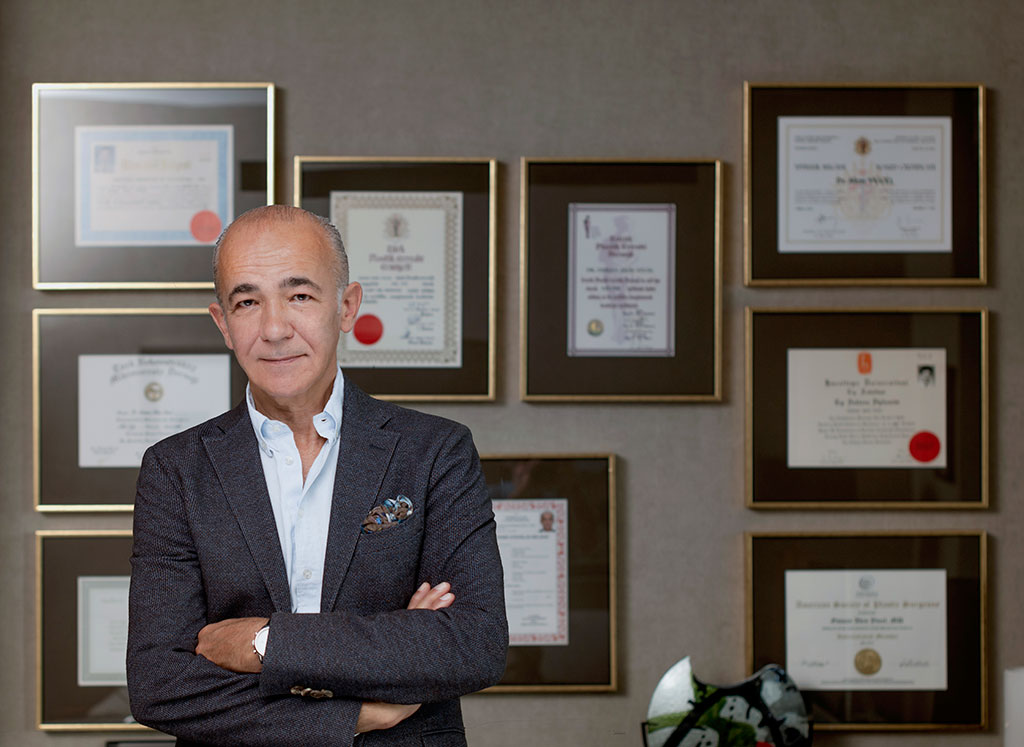The upper face comprises forehead, eyebrows and upper eyelids. Common rejuvenations methods are: open or endoscopic forehead tightening, temple tightening, eyebrow lift, silhouette lift of the brows, upper eyelid tightening (blepharoplasty) and Botox injections. A frequently seen mistake in face rejuvenation is eyebrows that are lifted too high. The face looks like frozen in astonishment. When consulting their surgeon, patients should bring photos along that show their appearance of 10-15 years ago. They help to determine the proper eyebrow to eye distance. In particular in men, the distance must not be exaggerated.
Frequently asked questions about upper face rejuvenation and brow lift:
Who is a good candidate for forehead and brow lift?
Persons whose brows sag with advancing age, and persons with structurally low-lying brows may consider a lift. Some people consult a surgeon about sagging upper lids only to find out that this is related to their brows. In these cases, lid tightening alone is not recommend because it would further shorten the eye to brow distance which is aesthetically not very pleasing.
How are forehead and brow lift performed?
Several techniques for brow lift exist. The individual method is chosen on the basis of the concrete case (form of the brows, their position, the anatomy of the patient) and the patient’s preferences.
- For a slight lift of the corners of the brows and for the removal of wrinkles in the corner of the eye, Botox (link) injections are sufficient
- In more advanced cases, silhouette lift (link) is an option. This method is not very long-lasting, however
- More durable is a temple lift, including the eye region, which requires a small incision in the scalp
- If the forehead skin is very loose and full of wrinkles, and if the distance between the eyes and the brows has noticeably narrowed, a full forehead lift is advised. The intervention is carried out endoscopically through a small incision in the skin. Through the cut, a mini camera is inserted and used to guide the surgical instruments under the skin. In this procedure, the skin is peeled directly off the bone in the forehead and brow area and around eyes, and this “mask” is then lifted and anchored a little higher up on the facial bone structure. In this process, the muscles responsible for frowning may be cut to permanently prevent them from wrinkling the skin. This so-called subperiosteal endoscopic facelift is the most effective method for forehead tightening and brow lifting.
- In bald men, the brows are lifted through an incision in the upper eyelid. This incision is part of the eyelid tightening and thus no additional intervention.
What to do and what not to do before treatment?
Three weeks before an invasive / surgical treatment patient must stop smoking and taking aspirin. In the last week, patients must stop taking any anticoagulant (“blood-thinning”) medicine.
The following substances are also prohibited:
- pain killers such as Apranax, Voltaren and Vermidon (alternative brand names are Minoset and Novalgin)
- multivitamin tablets containing ginseng, ginkgo biloba and coenzyme Q,
- green tea, herbal products containing linseed, sour cherry stalks, tomato seeds
- all diet products.
Does the procedure require anaesthesia?
For brow and temple lifts, local aesthesia is sufficient. The endoscopic forehead lift is performed in a clinic under general anaesthesia or under sedation.
How long does the procedure take?
A brow lift takes 30 minutes, a temple lift 1 hour, and an endoscopic forehead lift 1-1.5 hours.
Is the procedure painful?
Brow and temple lifts are not painful. The endoscopic forehead lift may be accompanied by pain and a feeling of tightness which are easily controlled with pain medication.
What happens after the operation?
A silhouette lift can be carried out in the surgeon’s office, and patients can immediately return home after the procedure. After a temple and forehead lift, patients can eat 3 hours later and are usually discharged after 6 hours. An elastic bandage may be wrapped around the forehead. It is removed the next day and the patient can take a bath. Brow and temple lifts are rarely accompanied by swelling and bruising. Endoscopic forehead tightening causes swelling in the eye region which may only dissolve after 20 days. Like with all other face operations, patients are strongly advised to avoid direct exposure to sunlight for the next 3 months.
What problems can occur after the operation?
Silhouette lift of the brows is only a temporary solution. The swelling after endoscopic surgery are not very pleasant, but they dissolve over time. Temple and forehead lift may cause temporary paralysis of the brow muscles; only in rare cases is this condition permanent. If the muscle failure is asymmetric, Botox is used to rebalance the appearance. If the brow lift is not carried out with the necessary professional care, the brows may end up too high or not symmetrically.
Are the results of the procedure permanent?
A silhouette lift of the brows lasts for about 1-2 years. Temple and forehead lifts are longer lasting; an endoscopic forehead lift is permanent.

